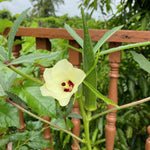Subscribe and save 10%!

Okra (Abelmoschus esculentus)
28 SEK
Unit price perExpected delivery date: 20 December to 27 December.
Applies to orders within Sweden. For other countries - see our delivery terms .
In stock - Ready to be shipped
Share
SEEDS (20pcs/bag)
Common name: Okra, Lady's Fingers, Gumbo, Bendi
Scientific name: Abelmoschus esculentus
Family: Malvaceae
Plant history & use:
Okra is a plant with many uses and its fruits are one of the most popular tropical vegetables worldwide.
The fruit is a well-used ingredient in cooking thanks to its crispy texture and gelatinous, texture-giving properties. The fruit contains binding substances, which makes it very suitable for stews and soups. It can also be eaten raw - for example in Asian cuisine it is often served alongside the main course as a raw vegetable together with accompanying sauce.
Like spinach, the leaves can be used raw in salads or thrown into a wok. Even the leaves possess slightly binding properties.
Roasted okra seeds can also be used as a caffeine-free alternative to coffee.
In West Africa, where okra is widely cultivated, flower buds and the blossoms are also eaten.
The average nutritional value of okra is higher than that of tomato, eggplant, most cucumber plants and many other common vegetables.
Okra seeds contain approximately 20% protein as well as 20% oil which can be extracted from the seeds.
Cultivation:
Okra originates from South Asia/Africa and is in its natural environment a perennial. It thrives in heat and is sensitive to frost. Optimum growth temperature is 20+ ºC and temperatures below 10 ºC can be harmful to the plant.
For the above mentioned reasons, Okra therefore grows best in greenhouses/cultivation tunnels if you are growing in northern Europe. It can be grown outdoors, but the harvest may be slightly less than what would be possible under optimal conditions. To improve the conditions for outdoor cultivation, in the spring when the soil has warmed up, you can cover the ground with plastic or other ground cover such as straw/bark to prevent heat radiation and thereby extend the growing season towards the autumn.
It is however stated that Okra is capable of growing outdoors as an annual over the summer months all the way down to USDA Zone 5. This does not imply overwintering outdoors in USDA Zone 5.
If you are living in southern Europe: Spain, Italy, Greece, Turkey and parts of France and the Balkan region - you can grow Okra as a perennial outdoors, all year round. See the European USDA Zone Hardiness Map for reference.
The okra is drought-resistant, but fruit formation is favored by consistent irrigation and nutrient supplementing.
Grows best in well-drained loamy soil.
Okra is self-pollinating which means you only need one plant to produce fruit.
The fruits are harvested at an early (unripe) stage while they are green to avoid a woody taste. One tip is to try breaking off the tip of the fruit - if it breaks, it's fresh, if it bends instead, it's too ripe and the fruit is better suited for seed harvesting.
Sowing:
Soak the seeds in water for 24 hours before sowing. Sow the seeds in moist soil and cover with a 1-2 cm layer of soil. Keep the soil moist. The seeds should germinate after 2-3 weeks. Germination happens faster at temperatures above 25 ºC.
Characteristics:
Lifespan: Perennial
Location: Sun
Height: 1–2 m
Germination Time: 1-8 weeks
USDA Zone: (5*)9-12
*grown as an annual = no overwintering outdoors
- Choosing a selection results in a full page refresh.
- Opens in a new window.





